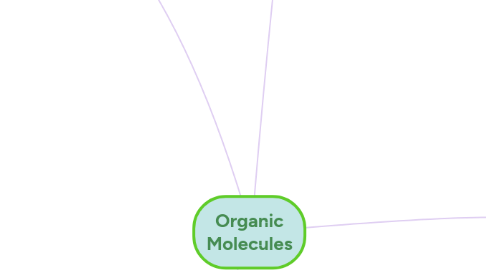
1. Carbohydrates
1.1. Elemental Composition
1.1.1. Carbon
1.1.2. Hydrogen
1.1.3. Oxygen
1.2. Monosaccharide (Monomer)
1.2.1. Glucose (biological)
1.2.2. Fructose (fruit&honey)
1.2.3. Galactose (dairy products)
1.3. Disaccharide
1.3.1. Sucrose = Glucose + fructose
1.3.2. Lactose = Glucose + Galactose
1.3.3. Maltose = Glucose + Glucose
1.4. Polysaccharide (Polymer)
1.4.1. Energy Storage
1.4.1.1. Starch (plant)
1.4.1.2. Glycogen (animal)
1.4.2. Structural Support
1.4.2.1. Cellulose (plant)
1.4.2.2. Chitin (animal)
2. Lipids
2.1. Elemental Composition
2.1.1. Carbon
2.1.2. Hydrogen
2.1.3. Oxygen (very few)
2.2. Types
2.2.1. Triglyceride (Fat/Oil)
2.2.1.1. Function
2.2.1.1.1. Long-term Energy Storage
2.2.1.2. Monomer
2.2.1.2.1. 1 glycerol + 3 fatty acids
2.2.1.3. Dehydration
2.2.1.3.1. Break to use
2.2.1.4. Hydrolysis
2.2.1.4.1. Combine to store energy
2.2.1.5. Types of Fat
2.2.1.5.1. Saturated Fat
2.2.1.5.2. Unsaturated Fat
2.2.1.6. Types of Fatty Acid
2.2.1.6.1. Saturated fatty acid
2.2.1.6.2. Unsaturated fatty acid
2.2.2. Phospholipid
2.2.2.1. Function
2.2.2.1.1. Structural Component of Cell Membrane
2.2.2.2. Monomer
2.2.2.2.1. 1 glycerol + 2 fatty acid + phosphate group
2.2.2.3. Component
2.2.2.3.1. Head
2.2.2.3.2. Tail
2.2.2.4. Structure = Bilayersheet
2.2.2.4.1. heads are outside
2.2.2.4.2. Tails are inside
2.2.2.4.3. allows things with no charge
2.2.2.5. Importance
2.2.2.5.1. All cells are made up of Phospholipid Bilayer Membrane
2.2.3. Steroid
2.2.3.1. Function
2.2.3.1.1. Cell Communication
2.2.3.1.2. Structural components of animal cell membrane
2.2.3.2. Monomer
2.2.3.2.1. 4 Fused Carbon Rings
2.2.3.2.2. No fatty acids
2.2.3.3. Example
2.2.3.3.1. Cholesterol
2.2.3.3.2. Vitamin D
2.2.3.3.3. Hormones
2.2.4. Wax
2.2.4.1. Function
2.2.4.1.1. Protection
2.2.4.2. Monomer
2.2.4.2.1. Long chain of fatty acid + Long chain of alcohol
2.2.4.3. Example
2.2.4.3.1. Beeswax
2.2.4.3.2. Earwax
2.2.4.3.3. Plant Cuticle
3. Proteins
3.1. Elemental Composition
3.1.1. Carbon
3.1.2. Hydrogen
3.1.3. Oxygen
3.1.4. Nitrogen
3.1.5. Sulfur
3.2. Functions
3.2.1. Metabolism
3.2.2. Regulation
3.2.3. Transport
3.2.4. Defense
3.2.5. Support
3.2.6. Movement
3.3. Monomer
3.3.1. Amino acid (20)
3.3.1.1. Differences
3.3.1.1.1. R group makes all 20 amino acids different
3.3.1.2. Similarities
3.3.1.2.1. All have amino group and acidic group.
3.4. R Group (Side Chain)
3.4.1. Positive & Negative
3.4.2. Hydrophilic & Hydrophobic
3.4.3. Cysteine
3.5. Building Blocks
3.5.1. Amino acid --> Dipeptide --> Polypeptide
3.6. Protein VS Polypeptide
3.6.1. Protein is a polypeptide that folds into a specific shape.
3.7. Hydrolysis
3.7.1. Rearranging the sequence of amino acid to form another functional protein
3.8. Dehydration
3.8.1. To make protein
3.9. Level of Protein Structure
3.9.1. Primary
3.9.1.1. Amino acids arrange into Polypeptide
3.9.2. Secondary
3.9.2.1. Polypeptide starting to foil into
3.9.2.1.1. Alpha Helix
3.9.2.1.2. Beta Sheet
3.9.3. Tertiary
3.9.3.1. Final shape of protein from polypeptide
3.9.4. Quaternary
3.9.4.1. 1+ polypeptide joining together
3.10. Protein Denaturation
3.10.1. When proteins lose their shapes&functions and can't go back to functional protein anymore
3.10.2. Causes
3.10.2.1. High temperature
3.10.2.2. Change in PH
3.10.2.3. Some chemicals
3.11. Bond
3.11.1. Peptide Bond
3.11.1.1. Covalent bond between amino acid
3.11.2. Hydrogen Bond
3.11.2.1. It is possible when peptide bond are close together
4. Nucleic Acid
4.1. Elemental Composition
4.1.1. Carbon
4.1.2. Hydrogen
4.1.3. Oxygen
4.1.4. Nitrogen
4.1.5. Phosphorus
4.2. Functions
4.2.1. Store genetic information
4.2.2. Controls the sequence of amino acids to form a particular protein
4.3. Types
4.3.1. DNA ( Deoxyribonucleic acid )
4.3.1.1. Store genetic information
4.3.1.2. 3 types
4.3.1.3. Located in the nucleus of the cell
4.3.2. Many functions e.g. help DNA to make the sequences of amino acids
4.3.3. RNA ( Ribonucleic acid )
4.3.3.1. 3 types
4.3.3.2. Located in the nucleus & cytoplasm
4.3.4. ATP ( Adenosine Triphosphate )
4.3.4.1. Specific nucleic acid
4.3.4.2. Store energy
4.3.4.3. High-energy molecule due to the presence of the last 2 unstable phosphate bond.
4.4. Monomer
4.4.1. Nucleotides
4.4.1.1. Components
4.4.1.1.1. Phosphate group
4.4.1.1.2. Pentose Sugar (5-carbon sugar)
4.4.1.1.3. Nitrogenous base
4.5. DNA
4.5.1. Deoxyribose Sugar
4.5.2. A,G,T,C
4.5.3. Double Helix
4.5.4. Double Strand
4.6. RNA
4.6.1. Ribose Sugar
4.6.2. A,U,G,C
4.6.3. Single Strand
4.6.4. No helix
4.7. DNA Structure
4.7.1. Base is attached with the sugar.
4.7.2. Hydrogen bond connects the 2 bases.
4.7.3. Covalent bond connects sugar and Phosphate.
4.7.4. Covalent Bond also connects the sugar and the base.
4.8. Complementary Base Pairing
4.8.1. Adenine <--> Thymine/ Uracil ( Double Bond )
4.8.2. Cytosine <--> Guanine ( Triple Bond )
4.9. ATP
4.9.1. Components
4.9.1.1. Ribose Sugar
4.9.1.2. 3 Phosphate Group
4.9.1.3. Adenine (A)
